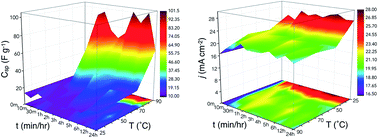An optimized mild reduction route towards excellent cobalt–graphene catalysts for water oxidation†
Abstract
Low cost yet efficient water oxidation catalysts are crucial in making economically competitive water electrolyzers and secondary metal–air batteries. In this study, we demonstrate the optimized mild reduction of graphene oxide towards the synthesis of highly active and stable cobalt–graphene electrocatalysts for water oxidation. Contrary to the conventional use of fully reduced graphene oxide (RGO) as a composite material in electrocatalysis, our results suggest that the oxygen functional groups, which are retained during mild GO reduction, are crucial in the formation of cobalt oxalate (CoC2O4) microstructures. Gently reduced graphene oxide (gRGO) with a low degree of reduction results in CoC2O4/gRGO microrods with impressive water oxidation activity, reaching current densities 21.1% higher than conventional iridium oxide-based catalysts and 70.5% more than the unoptimized CoC2O4/gRGO catalysts. Mild reduction of GO favors the homogeneous formation of microstructures via the negatively-charged functional groups, which attract the positive Co ions and lead to a stronger chemical interaction between the two components. This work points towards investigating and reevaluating the role of the degree of GO reduction on graphene's contribution to the composition and catalytic activity of metal–graphene composites.


 Please wait while we load your content...
Please wait while we load your content...